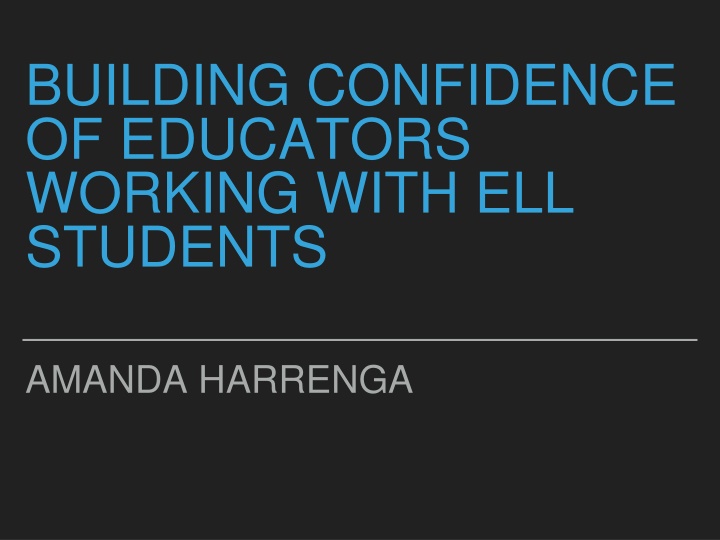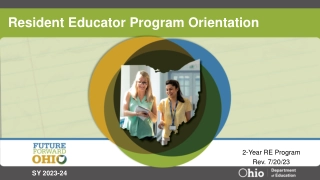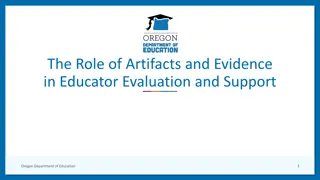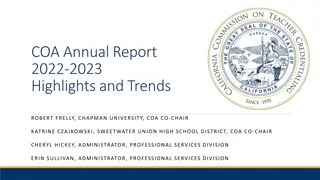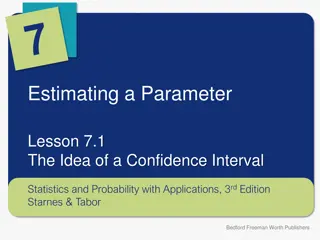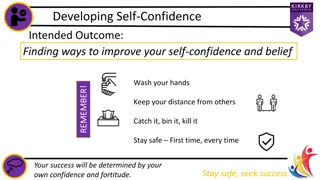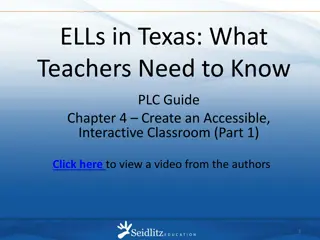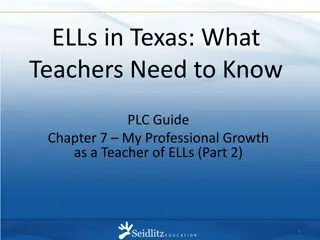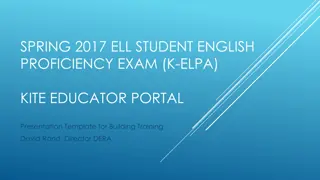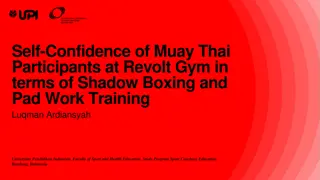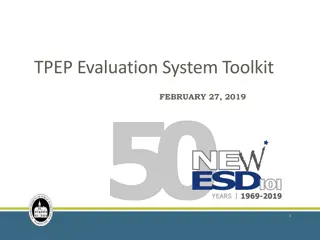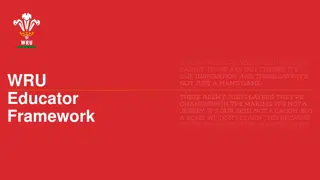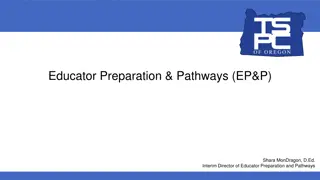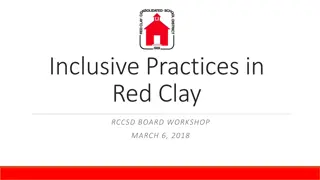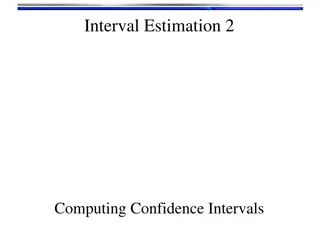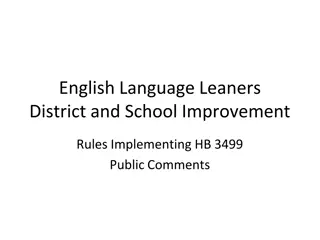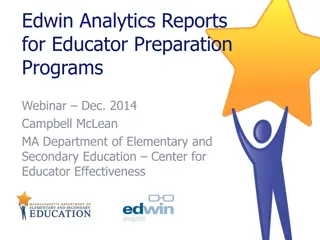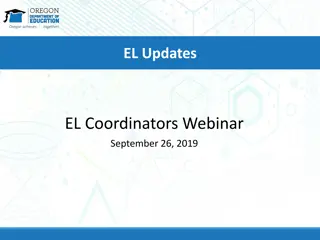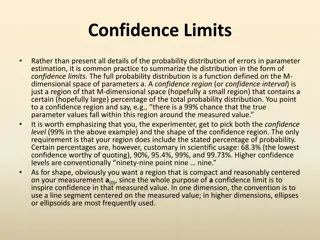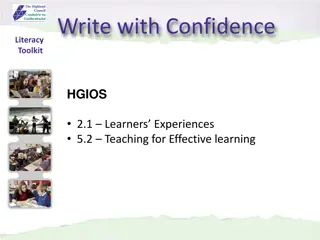Building Educator Confidence with ELL Students
This informative content discusses key aspects of working with English Language Learners (ELL), including understanding the ELL foundation, assessing language proficiency, and implementing effective strategies. It covers topics such as BICS and CALP, acquisition vs. learning, the importance of assessment, grammatical differences, and the progression of language development. The content emphasizes the significance of using assessment data to tailor instruction to meet students' needs successfully.
Uploaded on Apr 29, 2025 | 0 Views
Download Presentation

Please find below an Image/Link to download the presentation.
The content on the website is provided AS IS for your information and personal use only. It may not be sold, licensed, or shared on other websites without obtaining consent from the author.If you encounter any issues during the download, it is possible that the publisher has removed the file from their server.
You are allowed to download the files provided on this website for personal or commercial use, subject to the condition that they are used lawfully. All files are the property of their respective owners.
The content on the website is provided AS IS for your information and personal use only. It may not be sold, licensed, or shared on other websites without obtaining consent from the author.
E N D
Presentation Transcript
BUILDING CONFIDENCE OF EDUCATORS WORKING WITH ELL STUDENTS AMANDA HARRENGA
OBJECTIVES Who am I? ELL Foundation Assessing Motivating Building Strategies Why? Discussion/Questions
ELL Foundation BICS AND CALP CALP- Cognitive Academic Language Proficiency BICS - Basic Interpersonal Communication Skills school oriented playground chatter often times is content vocabulary or specific to classroom instruction basic communication everyday conversation Just because BICS seems developed, does not mean the students are ready for CALP
ELL Foundation ACQUISITION VS LEARNING Stephen Krashen s Acquisition Learning Hypothesis Acquisition -> the subconscious acceptance of knowledge of a language, same process used for first language Learning -> conscious acceptance of knowledge about a language ex. grammar rules, structure, and form
ASSESSMENT Why do we assess? National Assessments WIDA ACCESS - Accessing Comprehension and Communication in English State-to- State Can-do descriptors Informal and In-Class Assessments Helps guide day to day instruction. Easy to track and monitor student progress.
ASSESSMENT CONT. GRAMMATICAL DIFFERENCES How do the languages differ? How does this affect the development of English for your students? Easier to assess in a writing piece. Structure does not need immediate attention. Rich literary environment will provide initial context. Eventually, have short discussions and targeted lessons.
ASSESSMENT CONT. PROGRESSION OF LANGUAGE DEVELOPMENT Begins with the Here and Now BICS Both speakers can see each other, use verbal and visual cues Speakers have context from immediate surroundings. Ex. Put it there. Progresses to There and Later CALP Speakers cant see each other, fewer context clues. Abstract Ex. Photosynthesis
ASSESSMENT CONT. USING RESULTS Don t use assessments and not use the data. What does the data say students need to work on? How can that be implemented into instruction? Use what you know about your students as well as the data you acquire. What does using the data look like for our instruction and planning?
ASSESSMENT SELF REFLECTION It is important to look at our own biases and pedagogy to see how it affects the students learning and our teaching abilities. Think about the positives and how to improve negative situations. Think-pair-share: What is your classroom context?
MOTIVATION Motivation is not a stable variable and differs for each individual. Self Concept: an individuals perception of themselves as learners and self description about their competence Why is this useful? Self concept for ELLs in their L2 was positively associated with fluency. (Poor concept= poor fluency) How can we build self concept? Build a relationship, encourage, help students believe in themselves and their language progress but be realistic.
MOTIVATION CONT. INSPIRATION AND RELEVANCE What inspires us? How is that different for students? Teach in an environment that allows for students to explore while also making sense of the world around them. Students need to be able to connect in class learning (L2) to what they are exposed to out of school.
MOTIVATION CONT. AFFECTIVE FILTER Affective filter = stress, anxiety, alienation, self consciousness Higher affective filter = less learning Lower affective filter = more learning Design activities that scaffold learning and are aligned with learners affective needs. What does that mean? To align with learners affective needs means to also teach things that they need to be successful in reducing the affective filter or in their personal lives.
BUILDING FOUR DOMAINS OF LANGUAGE What are the four domains of language? Listening Speaking Reading Writing Listening and Speaking develop before Reading and Writing.
BUILDING CONT. LISTENING Listening is an active process that goes beyond decoding the information and involves the in-the-head knowledge about the language structure. Provide verbal, written, and (possibly) translated instructions. Speak slowly, but now louder (unless necessary, judgement call) Provide context for upcoming listening. (We are going to talk about ) Model what you want done. Be careful about the language you use is it easily known for an ELL or is it slang?
BUILDING CONT. SPEAKING Be patient and allow wait time. Teach skills that enable students to practice meaningfully speaking in multiple contexts and situations. Create a supportive classroom for talk that encourages discussion. Provide opportunities of low stress speaking. Provide feedback in the form of questions, comments, repetitions these allow for negotiation of meaning. Model good speaking.
BUILDING CONT. READING Identify possible barriers: vocabulary, culture, conceptual Address the barriers in scaffolded instruction. Focus on overall meaning of text and not word to word. Use the pictures and visuals efficiently. Explicitly teach reading strategies, model them and address multiple times in context. (Don t overwhelm) The Right Fit book. (Establish this with the whole class) Individual, partner, and group reading.
BUILDING CONT. WRITING Use sentence stems. Explicitly teach sentence structure and use it Understand differences in written language structure Encourage verbal discussion of ideas if students are struggling to think of things to write. Writing workshop is a great way to utilize mini-lessons and allow time to work on writing Write in meaningful contexts. Have students use vocabulary that you were working on in class.
UNIVERSAL STRATEGIES Have detailed language objectives. Grouping Include verbs and observable actions. Think-pair share, jigsaw Scaffold instruction. Mixed grouping. Students will graph and describe data in 3 forms. Pay attention to the ZPD (Zone of Proximal Development) Utilize technology! Students will think critically. Use personal dictionaries Build bridges between students languages. Allows students to write in both languages, and give them a reference for later. Use real life context and helpful vocabulary. Use students Funds of Knowledge
WHY IS THIS IMPORTANT? These strategies work for all students. There is a growing population of ELL s in the United States. Required by Federal Law that all ELL s be provided with an educational program that provides them with access to core curriculum and opportunities for language development. It can be intimidating not knowing where to start and what to do without a translator.
WRAP UP Resources for you! Resources: https://goo.gl/MmjjZZ Google Form https://goo.gl/Qrp1eN Questions?
